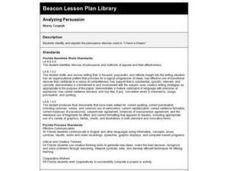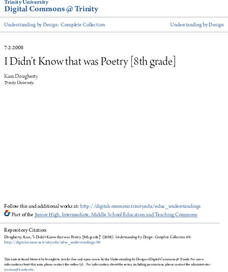Reed Novel Studies
Wolf Hollow: Novel Study
Annabelle, a young character in Wolf Hollow, discovers one bully can ruin everything when Betty walkes into her classroom. Betty bullies others and targets a war veteran. Individuals read how one person changed Annabelle's life. They...
Reed Novel Studies
The Witches: Novel Study
Are witches like lions in sheep clothing? A boy and his grandmother in The Witches thinks so. They have even discovered the secret to recognizing these evil beings that disguise themselves as sweet ladies. Scholars use the resource to...
Reed Novel Studies
Rules: Novel Study
Have you ever been so focused on others, that a look in the mirror surprises you? It seems that Catherine, a character in Rules, does just that when she focuses so much on her autistic brother's behaviors that she is surprised by her own...
K20 LEARN
Here's How I Heard It: Using Folklore To Improve Close Reading Skills
"X" is for exaggeration, and "F" is for fact. To encourage close reading and to improve literary analysis skills, class members annotate fables and tall tales, like Paul Bunyan, with symbols that identify key features of this genre.
Newseum
Weed Out Propaganda
Young scholars study four essential propaganda techniques: Simplification, Exploitation, Exaggeration, and Division (S.E.E.D.). Individuals select an example of propaganda from the past and present then compare how the key elements have...
Curated OER
Quirky Quatrain Poetry Lesson
Middle schoolers discover what a quatrain is, and are taught the three poetic devices: alliteration, hyperbole, and onomatopoeia. Everyone chooses a favorite hobby or activity, then attempts to write a poem about it. They must write two...
Curated OER
Imagine That! Analyzing Imagery
Poems by O. Henry, Marion Dane Bauer, Monty Roberts, and Langston Hughes provide the text for a study of symbolism, hyperbole, and imagery. Employing the “think-pair-share” strategy learners generate definitions of these terms and locate...
Eastconn
Learning to Analyze Political Cartoons with Lincoln as a Case Study
Discover the five main elements political cartoonists use—symbolism, captioning and labels, analogy, irony, and exaggeration—to convey their point of view.
Curated OER
An Anecdote is Worth a Thousand Pictures
Students identify anecdotes in speeches and the purposes that politicians use the anecdotes for. They create personal anecdotes for the class to hear, and students decide if the anecdote is real or fabricated.
Curated OER
I Know Why the Caged Bird Sings: Chapters 34, 35
Young scholars analyze Maya Angelou's I Know Why the Caged Bird Sings in part of an analysis of imagery. In this Maya Angelou lesson, students read chapters 34 and 35 in the novel and define imager. Young scholars work in pairs to locate...
Curated OER
Figurative Language 2
Students read nursery rhymes and advertisements to identify examples of figurative language. As a class, students discuss the use of figurative language and its effectiveness in advertising, children's books, rhymes, poetry, etc. ...
Curated OER
Figurative Language Project
Want a handy way to remember the difference between metaphors and similes, or allusions and alliteration? Individuals craft their own figurative language booklet, complete with definitions, examples, and illustrations, following...
Curated OER
Analyzing Persuasion
A reading of Dr. Martin Luther King Jr.'s "I Have a Dream" speech launches a study of rhetorical devices such as hyperbole, allusion, metaphor, simile, personification, connotative language and parallel structure. Class members then...
Shakespeare Globe Trust
Twelfth Night
Whether you choose to include Twelfth Night in your course or whether Shakespeare's comedy has been thrust upon you, be not afraid to incorporate an interactive resource into your study of Shakespeare's tale of loss, love, and identity....
Trinity University
I Didn’t Know that was Poetry
Poetry or prose? That is the question facing middle schoolers as they begin a month-long poetry unit by examining the characteristics that differentiate poetry and prose writing. Pupils learn about poetic devices and different types of...
Curated OER
Political Cartoons Illustrating Progressivism and the Election of 1912
High schoolers study a current political cartoon to introduce the ideas of symbolism, humor, exaggeration, and caricature in editorial cartoons. They study cartoons from the past to gain an understanding of the culture of 1912.
National First Ladies' Library
All the News That's Fit to Draw: Political Cartooning and the Presidency
Young scholars research, analyze and study the history of political cartooning in the United States. They recognize a political cartoon, be able to identify the main idea, the symbols and the exaggeration and caricature in political...
Curated OER
Greek Theater Masks
Sixth graders learn the importance of mask in Greek theater, explore the history of Greek theater, integrate planning - design and construct a mask that shows exaggeration of features, build up features using paper mach mash, enhance...
Curated OER
History According to Shakespeare
Middle schoolers read Shakespeare's, Julius Caesar while identifying a number of literary elements including simile, metaphor, personification, and hyperbole. As a response activity, they simulate a mock trial, and finally, compare and...
Curated OER
Art Lesson: Doll Making
Students read and discuss the main characters and supporting characters in the African folktale, "Tiger and the Big Wind." They highlight the physical features of the animal that makes them unique and transfers those same qualities to...
K12 Reader
Figurative Language: What Is It?
"Lucky lady." "Straight as an arrow." Here's a figurative language learning exercise that provides middle schoolers with six examples and asks them to identify the literary device modeled.
K12 Reader
Working with Figurative Language
Are your middle schoolers able to identify the literary devices featured on this worksheet? They must demonstrate their understanding of figurative language by matching the terms with their definitions and label the devices used in short...
E Reading Worksheets
Figurative Language Finder
To demonstrate their understanding of figurative language, middle schoolers use a guided reading worksheet to find examples of figurative language in a text, identify the technique being used, and to explain how they were able to...
Florida Center for Reading Research
Vocabulary: Words in Context, Pun Fun
Scholars explore a variety of texts to locate wordplay. Partners read their selections and discuss meanings.























